Abstract
Progress in public health and community-based interventions has been hampered by the lack of a comprehensive evaluation framework appropriate to such programs. Multilevel interventions that incorporate policy, environmental, and individual components should be evaluated with measurements suited to their settings, goals, and purpose. In this commentary, the authors propose a model (termed the RE-AIM model) for evaluating public health interventions that assesses 5 dimensions: reach, efficacy, adoption, implementation, and maintenance. These dimensions occur at multiple levels (e.g., individual, clinic or organization, community) and interact to determine the public health or population-based impact of a program or policy. The authors discuss issues in evaluating each of these dimensions and combining them to determine overall public health impact. Failure to adequately evaluate programs on all 5 dimensions can lead to a waste of resources, discontinuities between stages of research, and failure to improve public health to the limits of our capacity. The authors summarize strengths and limitations of the RE-AIM model and recommend areas for future research and application.
Full text
PDF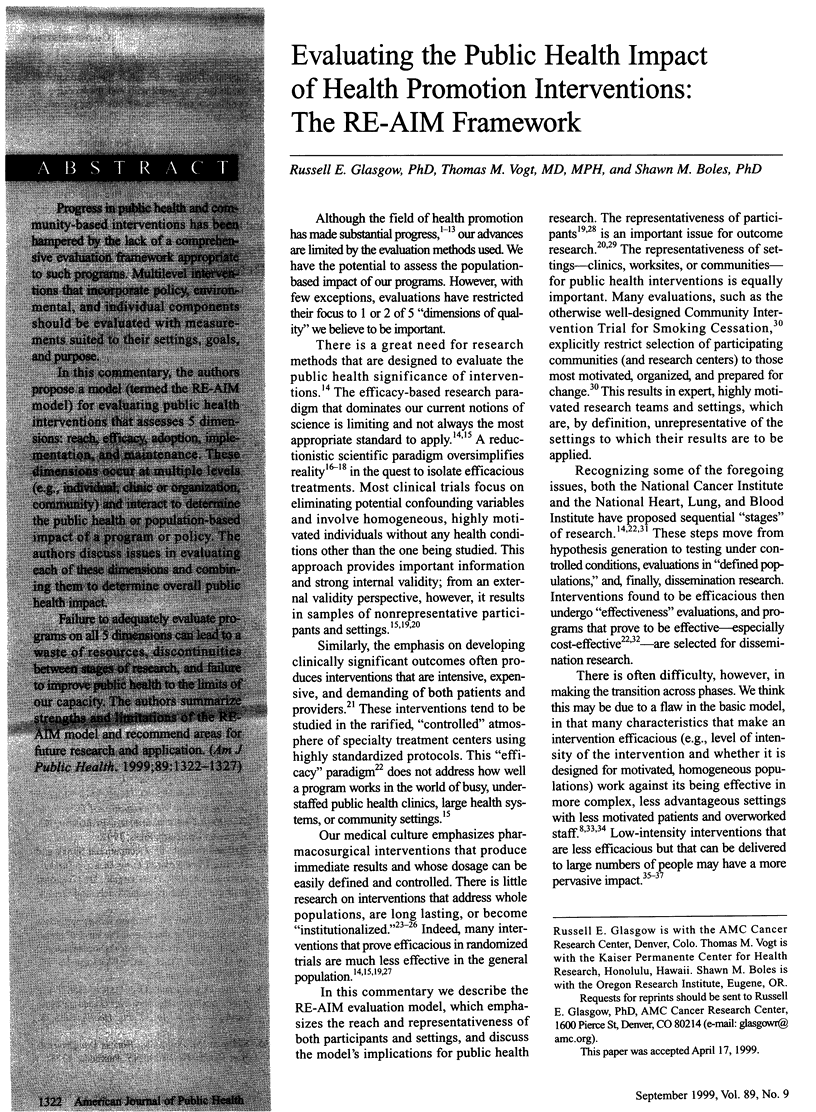
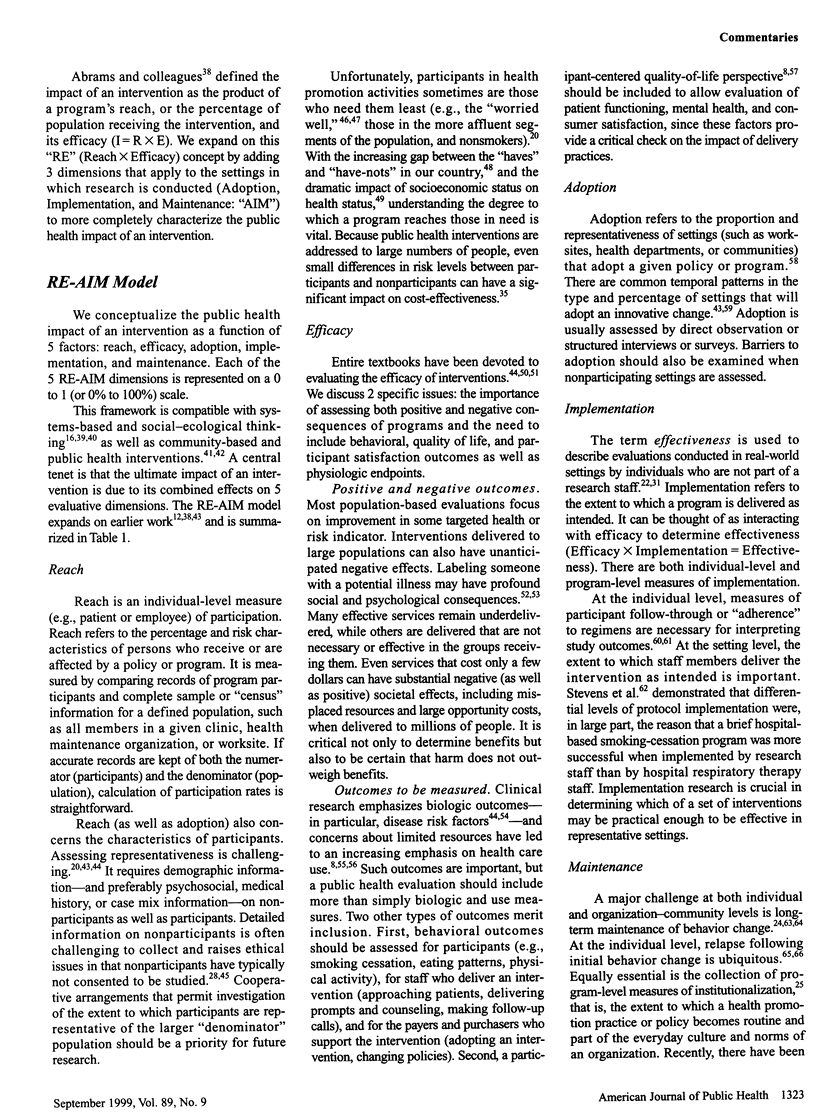
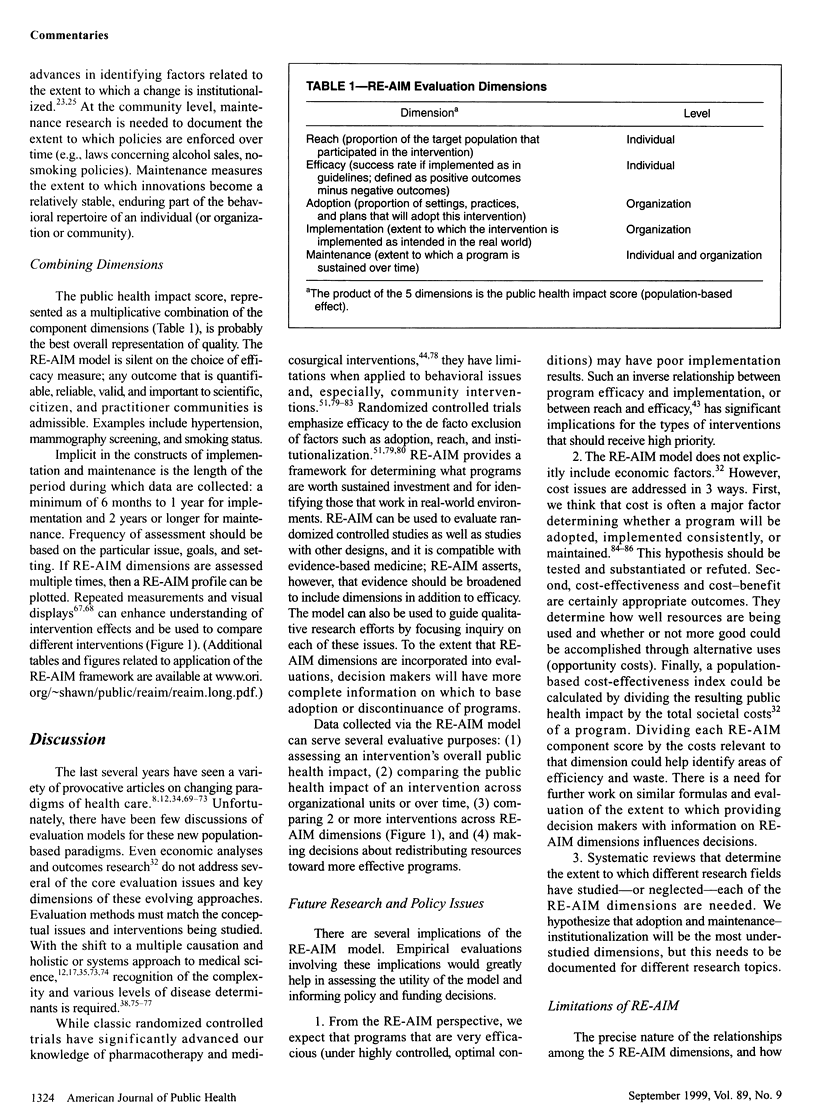
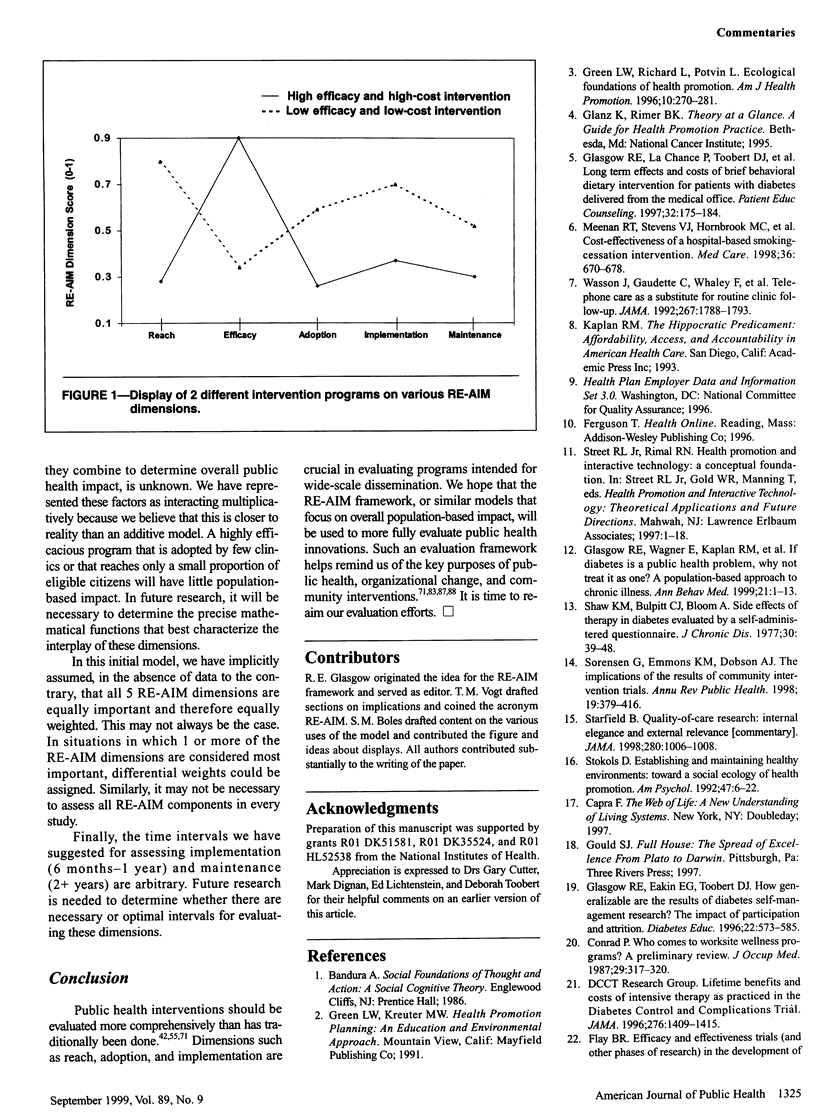
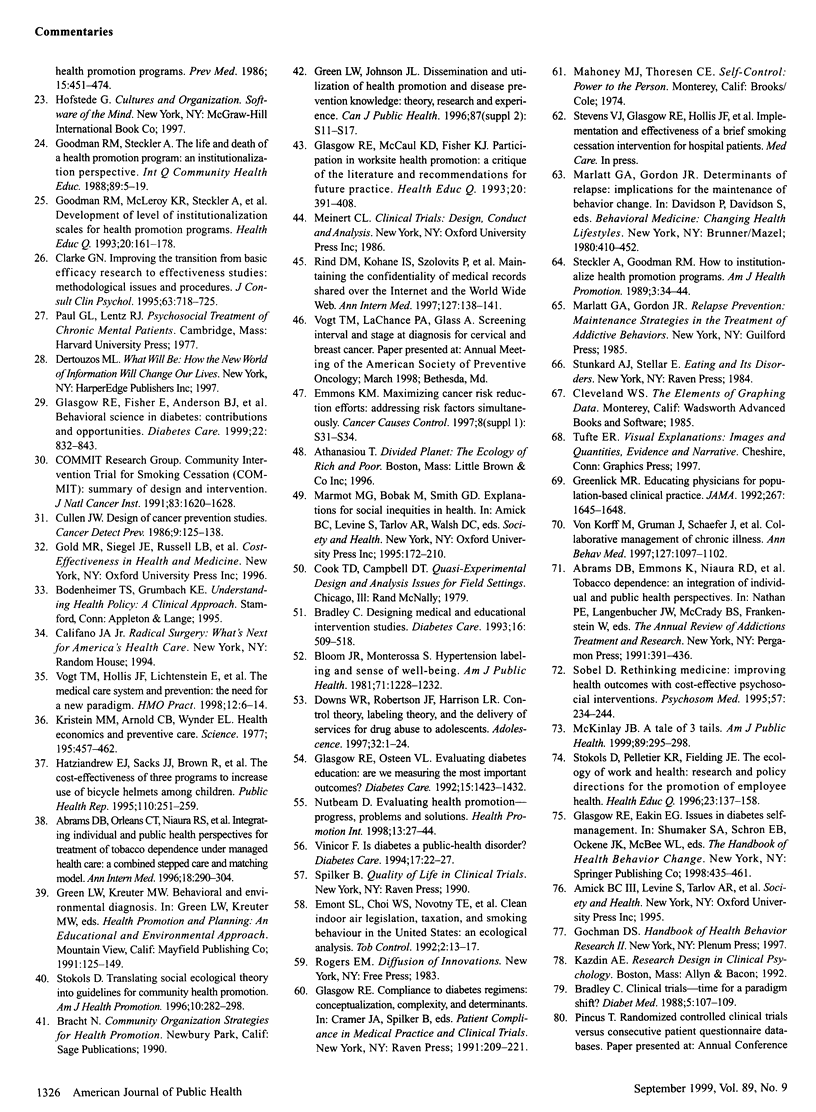
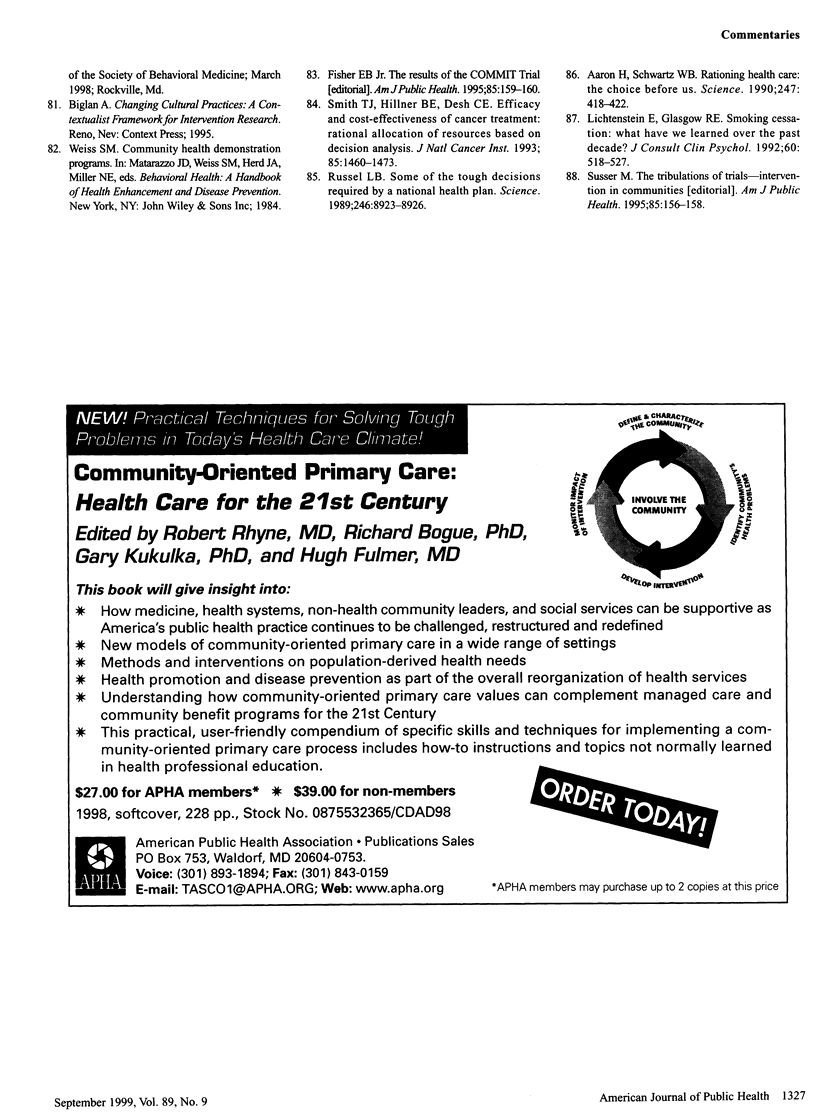
Selected References
These references are in PubMed. This may not be the complete list of references from this article.
- Aaron H., Schwartz W. B. Rationing health care: the choice before us. Science. 1990 Jan 26;247(4941):418–422. doi: 10.1126/science.2300804. [DOI] [PubMed] [Google Scholar]
- Bloom J. R., Monterossa S. Hypertension labeling and sense of well-being. Am J Public Health. 1981 Nov;71(11):1228–1232. doi: 10.2105/ajph.71.11.1228. [DOI] [PMC free article] [PubMed] [Google Scholar]
- Bradley C. Clinical trials--time for a paradigm shift? Diabet Med. 1988 Mar;5(2):107–109. doi: 10.1111/j.1464-5491.1988.tb00954.x. [DOI] [PubMed] [Google Scholar]
- Bradley C. Designing medical and educational intervention studies. A review of some alternatives to conventional randomized controlled trials. Diabetes Care. 1993 Feb;16(2):509–518. doi: 10.2337/diacare.16.2.509. [DOI] [PubMed] [Google Scholar]
- Clarke G. N. Improving the transition from basic efficacy research to effectiveness studies: methodological issues and procedures. J Consult Clin Psychol. 1995 Oct;63(5):718–725. doi: 10.1037//0022-006x.63.5.718. [DOI] [PubMed] [Google Scholar]
- Conrad P. Who comes to work-site wellness programs? A preliminary review. J Occup Med. 1987 Apr;29(4):317–320. [PubMed] [Google Scholar]
- Cullen J. W. Design of cancer prevention studies. Cancer Detect Prev. 1986;9(1-2):125–138. [PubMed] [Google Scholar]
- Downs W. R., Robertson J. F., Harrison L. R. Control theory, labeling theory, and the delivery of services for drug abuse to adolescents. Adolescence. 1997 Spring;32(125):1–24. [PubMed] [Google Scholar]
- Emmons K. M. Maximizing cancer risk reduction efforts: addressing multiple risk factors simultaneously. Cancer Causes Control. 1997 Nov;8 (Suppl 1):S31–S34. [PubMed] [Google Scholar]
- Fisher E. B., Jr The results of the COMMIT trial. Community Intervention Trial for Smoking Cessation. Am J Public Health. 1995 Feb;85(2):159–160. doi: 10.2105/ajph.85.2.159. [DOI] [PMC free article] [PubMed] [Google Scholar]
- Glasgow R. E., Eakin E. G., Toobert D. J. How generalizable are the results of diabetes self-management research? The impact of participation and attrition. Diabetes Educ. 1996 Nov-Dec;22(6):573-4, 581-2, 584-5. doi: 10.1177/014572179602200605. [DOI] [PubMed] [Google Scholar]
- Glasgow R. E., Fisher E. B., Anderson B. J., LaGreca A., Marrero D., Johnson S. B., Rubin R. R., Cox D. J. Behavioral science in diabetes. Contributions and opportunities. Diabetes Care. 1999 May;22(5):832–843. doi: 10.2337/diacare.22.5.832. [DOI] [PubMed] [Google Scholar]
- Glasgow R. E., La Chance P. A., Toobert D. J., Brown J., Hampson S. E., Riddle M. C. Long-term effects and costs of brief behavioural dietary intervention for patients with diabetes delivered from the medical office. Patient Educ Couns. 1997 Nov;32(3):175–184. doi: 10.1016/s0738-3991(97)00039-6. [DOI] [PubMed] [Google Scholar]
- Glasgow R. E., McCaul K. D., Fisher K. J. Participation in worksite health promotion: a critique of the literature and recommendations for future practice. Health Educ Q. 1993 Fall;20(3):391–408. doi: 10.1177/109019819302000309. [DOI] [PubMed] [Google Scholar]
- Glasgow R. E., Osteen V. L. Evaluating diabetes education. Are we measuring the most important outcomes? Diabetes Care. 1992 Oct;15(10):1423–1432. doi: 10.2337/diacare.15.10.1423. [DOI] [PubMed] [Google Scholar]
- Goodman R. M., McLeroy K. R., Steckler A. B., Hoyle R. H. Development of level of institutionalization scales for health promotion programs. Health Educ Q. 1993 Summer;20(2):161–178. doi: 10.1177/109019819302000208. [DOI] [PubMed] [Google Scholar]
- Green L. W., Richard L., Potvin L. Ecological foundations of health promotion. Am J Health Promot. 1996 Mar-Apr;10(4):270–281. doi: 10.4278/0890-1171-10.4.270. [DOI] [PubMed] [Google Scholar]
- Greenlick M. R. Educating physicians for population-based clinical practice. JAMA. 1992 Mar 25;267(12):1645–1648. [PubMed] [Google Scholar]
- Hatziandreu E. J., Sacks J. J., Brown R., Taylor W. R., Rosenberg M. L., Graham J. D. The cost effectiveness of three programs to increase use of bicycle helmets among children. Public Health Rep. 1995 May-Jun;110(3):251–259. [PMC free article] [PubMed] [Google Scholar]
- Kristein M. M., Arnold C. B., Wynder E. L. Health economics and preventive care. Science. 1977 Feb 4;195(4277):457–462. doi: 10.1126/science.402026. [DOI] [PubMed] [Google Scholar]
- Lichtenstein E., Glasgow R. E. Smoking cessation: what have we learned over the past decade? J Consult Clin Psychol. 1992 Aug;60(4):518–527. doi: 10.1037//0022-006x.60.4.518. [DOI] [PubMed] [Google Scholar]
- McKinlay J. B., Marceau L. D. A tale of 3 tails. Am J Public Health. 1999 Mar;89(3):295–298. doi: 10.2105/ajph.89.3.295. [DOI] [PMC free article] [PubMed] [Google Scholar]
- Meenan R. T., Stevens V. J., Hornbrook M. C., La Chance P. A., Glasgow R. E., Hollis J. F., Lichtenstein E., Vogt T. M. Cost-effectiveness of a hospital-based smoking cessation intervention. Med Care. 1998 May;36(5):670–678. doi: 10.1097/00005650-199805000-00007. [DOI] [PubMed] [Google Scholar]
- Rind D. M., Kohane I. S., Szolovits P., Safran C., Chueh H. C., Barnett G. O. Maintaining the confidentiality of medical records shared over the Internet and the World Wide Web. Ann Intern Med. 1997 Jul 15;127(2):138–141. doi: 10.7326/0003-4819-127-2-199707150-00008. [DOI] [PubMed] [Google Scholar]
- Shaw K. M., Bulpitt C. J., Bloom A. Side effects of therapy in diabetes evaluated by a self-administered questionnaire. J Chronic Dis. 1977 Jan;30(1):39–48. doi: 10.1016/0021-9681(77)90050-9. [DOI] [PubMed] [Google Scholar]
- Smith T. J., Hillner B. E., Desch C. E. Efficacy and cost-effectiveness of cancer treatment: rational allocation of resources based on decision analysis. J Natl Cancer Inst. 1993 Sep 15;85(18):1460–1474. doi: 10.1093/jnci/85.18.1460. [DOI] [PubMed] [Google Scholar]
- Sobel D. S. Rethinking medicine: improving health outcomes with cost-effective psychosocial interventions. Psychosom Med. 1995 May-Jun;57(3):234–244. doi: 10.1097/00006842-199505000-00005. [DOI] [PubMed] [Google Scholar]
- Sorensen G., Emmons K., Hunt M. K., Johnston D. Implications of the results of community intervention trials. Annu Rev Public Health. 1998;19:379–416. doi: 10.1146/annurev.publhealth.19.1.379. [DOI] [PubMed] [Google Scholar]
- Starfield B. Quality-of-care research: internal elegance and external relevance. JAMA. 1998 Sep 16;280(11):1006–1008. doi: 10.1001/jama.280.11.1006. [DOI] [PubMed] [Google Scholar]
- Stokols D. Establishing and maintaining healthy environments. Toward a social ecology of health promotion. Am Psychol. 1992 Jan;47(1):6–22. doi: 10.1037//0003-066x.47.1.6. [DOI] [PubMed] [Google Scholar]
- Stokols D., Pelletier K. R., Fielding J. E. The ecology of work and health: research and policy directions for the promotion of employee health. Health Educ Q. 1996 May;23(2):137–158. doi: 10.1177/109019819602300202. [DOI] [PubMed] [Google Scholar]
- Stokols D. Translating social ecological theory into guidelines for community health promotion. Am J Health Promot. 1996 Mar-Apr;10(4):282–298. doi: 10.4278/0890-1171-10.4.282. [DOI] [PubMed] [Google Scholar]
- Susser M. The tribulations of trials--intervention in communities. Am J Public Health. 1995 Feb;85(2):156–158. doi: 10.2105/ajph.85.2.156. [DOI] [PMC free article] [PubMed] [Google Scholar]
- Vinicor F. Is diabetes a public-health disorder? Diabetes Care. 1994 Jun;17 (Suppl 1):22–27. [PubMed] [Google Scholar]
- Von Korff M., Gruman J., Schaefer J., Curry S. J., Wagner E. H. Collaborative management of chronic illness. Ann Intern Med. 1997 Dec 15;127(12):1097–1102. doi: 10.7326/0003-4819-127-12-199712150-00008. [DOI] [PubMed] [Google Scholar]
- Wasson J., Gaudette C., Whaley F., Sauvigne A., Baribeau P., Welch H. G. Telephone care as a substitute for routine clinic follow-up. JAMA. 1992 Apr 1;267(13):1788–1793. [PubMed] [Google Scholar]


